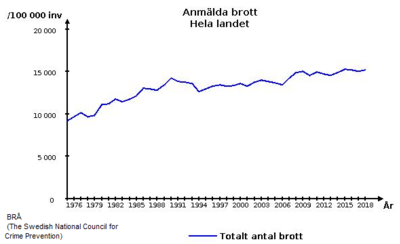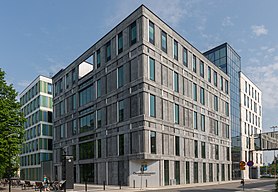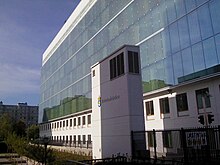Crime in Sweden
[6][7][8] The prosecutors are lawyers employed by the Swedish Prosecution Authority, a wholly independent organization not dependent on courts or the police, and not directed by the Ministry of Justice (any ministerial interference is in fact unconstitutional).[9] The prosecutor are obliged to lead and direct the preliminary investigations of a crime impartially and objective, make decisions on prosecution issues, and appear in court to process actions in criminal cases.[14] The legal and institutional framework in Sweden are considered effective in fighting against corruption, and the government agencies are characterized by a high degree of transparency, integrity and accountability.[23][non-primary source needed] In January 2017, the Löfven cabinet denied the request from member parliament Staffan Danielsson to update the BRÅ statistics on crime with respect to national or immigration background of the perpetrator, as had previously been done in 1995, 2005 but the 2015 was overdue.[28] The figures for fraud and property damage (excluding car theft) are in contrast with the numbers of reported crimes under such categories which have remained roughly constant over the period 2014–16.In the recently published SCS 2016, exposure to offences has increased to levels as seen prior to 2005, with 13.3% of the people surveyed reporting that they had been victim to one or more of the aforementioned crimes.[26]: 5–7 Sweden has a high rate of reported assault crime when compared internationally,[42] but this can be explained by legal, procedural and statistical differences.[7] The 2005 European Crime and Safety Survey (2005 EU ICS) found that prevalence victimisation rates for assaults with force was below average in Sweden.Swedish police do not record or release the ethnicity of convicted criminals, but Linda H Straaf head of intelligence at National Operations Department says they are from poor areas and many are second- or third-generation immigrants.[63][66] In 2018, a New York Times article said that gang violence was becoming more frequent, in part because of an increase in weapons flowing over the border with neighboring Denmark.[72] The rate of exposure to sexual offences has remained relatively unchanged, according to the SCS, since the first survey was conducted in 2006, despite an increase in the number of reported sex crimes.[73] This discrepancy can largely be explained by reforms in sex crime legislation, widening of the definition of rape,[74][75][76] and an effort by the Government to decrease the number of unreported cases.[75][77][78][79] In SCS 2013, 0.8 percent of respondents state that they were the victims of sexual offences, including rape; or an estimated 62,000 people of the general population (aged 16–79).[26]: 5–8 A frequently cited source when comparing Swedish rape statistics internationally is the regularly published report by the United Nations Office on Drugs and Crime (UNODC) — although they discourage this practice.[82][Note 1] According to a 2014 study published by the European Union Agency for Fundamental Rights (FRA), approximately one third of all women in the EU were said to have suffered physical and/or sexual abuse.[90] The number of rapes reported to the authorities in Sweden significantly increased[91] by 10% in 2017,[92][93] according to latest preliminary figures from the Swedish National Council for Crime Prevention.[93] Official numbers show that the incidence of sexual offences is on the rise;[90][91][93] the Government has declared that young women are facing the greatest risks and that most of the cases go unreported.[26]: 5–8 [94][Note 1] The prevalence victimisation rates for robbery was slightly above the EU-average in 2004, and lower than countries such as Ireland, Estonia, Greece, Spain, the United Kingdom and Poland.[102] The Swedish National Council for Crime Prevention received responsibility for compiling statistics in 1994, at which time the two main categories of offenders were youth and drug addicts.[citation needed] This pattern changed into one where the main category of offenders were organised gangs, some of which were composed of foreigners travelling to Sweden in order to commit crime and then return to their home countries again.[103] In 2017 police were reported as estimating that about half of the annual 20,000 burglaries, including failed attempts, were committed by gangs from the Balkans, Romania, the Baltic states and Georgia.[104] According to a survey by the Swedish Agency for Youth and Civil Society (MUCF), performed in 2018, and released in April 2019, 70% of men and 36% of women in the ages 16–29 years old were afraid of being subjected to violence when they are outside.[105][106][107] According to the 2017 EU-SILC survey, Sweden was one of the countries in Europe where the highest share of the population experience problems with crime, violence or vandalism in the area they live.[108] Sanctions under the Swedish Penal Code consist of fines and damages, imprisonment, conditional sentences, probation, being placed in special care and community service.A basic premise in the Penal Code is that non-custodial penalties are more desirable than custodial, and the court has considerable latitude when choosing a criminal sanctions, paying special attention to measures chiefly aimed at rehabilitating offenders.Such damages can relate to compensation for destroyed clothing, a broken tooth, costs for medical care, pain and suffering, or personal violation.The probation may be combined with day fines, imprisonment, an obligation to undergo care according to a predetermined treatment plan and/or to perform community service.[126] Several pieces by Norsk rikskringkasting, the state-run media channel in the neighboring country Norway have described the "no-go zones" as areas in which ambulances, the fire brigade and police are routinely attacked, with reporter Anders Magnus in 2016 threatened and hurled rocks at by masked men when he tried to make interviews in Husby.[127][128][129] Norwegian minister of immigration and integration Sylvi Listhaug and opposition politician Bård Vegard Solhjell said that they were "shocked" by the emergence of no-go zones in Sweden.[130] Another incidence of foreign journalists attacked in a Stockholm suburb includes the Australian team of Liz Hayes from CBS's 60 minutes in Rinkeby in 2016, working with anti-immigration activist Jan Sjunnesson,[131][132] in which a member of the crew was allegedly dragged into a building during filming and punched and kicked by several people.



SwedishSwedish lawsSwedish National Council for Crime PreventionWesternpostwar eraLaw enforcement in SwedenDistrict CourtÖrebroSwedish Prosecution AuthorityMinistry of Justiceministerial interferenceCourt of AppealCorruption in SwedencorruptionSwedenLinköping UniversitySwedish policegovernment agencyofficial statisticsLöfven cabinetStaffan Danielssonviolent crimesspousal rapegang rapeplea bargainingvictimisation surveysVulnerable areas in SwedenMurder (Swedish law)StockholmSkånehonor killingsmurders of womenDagens NyheterNational Criminal Investigation ServiceAftenpostenNorwaysocially vulnerableGun violence in SwedenWestern EuropeMinister for JusticeMorgan JohanssonBombings in SwedenList of grenade attacks in SwedenMexicoAnders ThornbergNational Operations DepartmentSwedish mediaNew York TimesDenmarkpassport controlsRape in SwedenProstitution in Swedengender equalitymarital rapethe Governmentunreported casesUnited Nations Office on Drugs and CrimeEuropean Union Agency for Fundamental Rightsrape statisticsimmigrantsEuropean UnionSouthern AfricansNorthern AfricansMiddle EasternsAfghansSwedish Televisionsex offendersMalmöEuropean migrant crisiscommunity cooperationPolice in SwedenLithuaniaPolandGeorgiaBelarusRomaniaBulgariaBalkansBaltic statesSwedish Agency for Youth and Civil Societyremand prisonSollentunadamagesimprisonmentprobationcommunity serviceCrime Victim Fundday finesprobation officerelectronic monitoringSwedish Prison and Probation ServiceNational Board of Health and WelfareNational Board of Institutional Careno-go zonesNorsk rikskringkastingAnders MagnusSylvi ListhaugBård Vegard SolhjellLiz HayesRinkebyTim PoolSwedish-KurdishTino Sanandajivulnerables areasNigel FarageEuropehigh number of rapes in Swedenasylum seekersAfricaMiddle EastFinns PartyMaria OhisaloVulnerable areaCrime Victim Compensation and Support AuthorityNational Centre for Knowledge on Men's Violence against WomenSweden-bashingHistorical murders and executions in StockholmList of countries by intentional homicide rateList of countries by incarceration rateGovernment of SwedenSupreme Court of SwedenMalmö UniversityUNICRIThe LocalThe GuardianThe New York Times